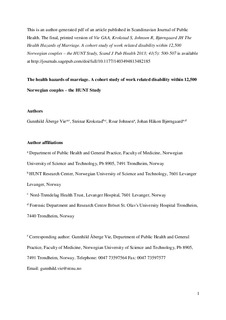| dc.contributor.author | Vie, Gunnhild Åberge | |
| dc.contributor.author | Krokstad, Steinar | |
| dc.contributor.author | Johnsen, Roar | |
| dc.contributor.author | Bjørngaard, Johan Håkon | |
| dc.date.accessioned | 2017-12-06T14:06:56Z | |
| dc.date.available | 2017-12-06T14:06:56Z | |
| dc.date.created | 2013-06-13T15:08:19Z | |
| dc.date.issued | 2013 | |
| dc.identifier.citation | Scandinavian Journal of Public Health. 2013, 41 (5), 500-507. | nb_NO |
| dc.identifier.issn | 1403-4948 | |
| dc.identifier.uri | http://hdl.handle.net/11250/2469422 | |
| dc.description.abstract | Aims: Work disability and sickness absence increase following partner’s retirement, which similarities in spouses’ health could explain. We therefore studied the risk of work disability within couples, taking account of baseline health, lifestyle and socioeconomic factors. Methods: A cohort of 12,511 couples from the HUNT Study (aged 20–67 years in HUNT2, 1995–1997) was linked to national registries, identifying all new cases of disability pension up until December 2007. Data were analysed with discrete time multilevel logistic regression and Cox regression models. Partners’ disability pension was included as a time-varying covariate. Follow-up time was split to examine the association dependent of time. Analyses were adjusted for age only, adjusted for health, and for lifestyle and education along with health. Results: About 15% of an individual’s propensity to receive a disability pension could be attributed couple similarity. There was an increased risk of work disability following the spouse’s disability retirement [HR (hazard ratio) 1.43 (95% confidence interval 1.20– 1.71) for men, HR 1.49 (95% confidence interval 1.28–1.74) for women]. The association was somewhat attenuated after adjustments for health, lifestyle and education. Conclusion: There was a substantial clustering of disability pensions within couples, which cannot be explained by similarities in health, lifestyle and education. This suggests partners influence each other’s work ability. From a clinical perspective, the family situation needs to be taken into account when addressing health promotion and work participation. | nb_NO |
| dc.language.iso | eng | nb_NO |
| dc.publisher | SAGE Publications | nb_NO |
| dc.relation.uri | http://sjp.sagepub.com/content/41/5/500.full.pdf+html | |
| dc.title | The Health Hazards of Marriage. A cohort study of work related disability within 12,500 Norwegian couples - the HUNT Study | nb_NO |
| dc.type | Journal article | nb_NO |
| dc.type | Peer reviewed | nb_NO |
| dc.description.version | acceptedVersion | nb_NO |
| dc.source.pagenumber | 500-507 | nb_NO |
| dc.source.volume | 41 | nb_NO |
| dc.source.journal | Scandinavian Journal of Public Health | nb_NO |
| dc.source.issue | 5 | nb_NO |
| dc.identifier.doi | 10.1177/1403494813482185 | |
| dc.identifier.cristin | 1034079 | |
| dc.description.localcode | © 2013 the Nordic Societies of Public Health. This is the authors' accepted and refereed manuscript to the article. The final publication is available at http://journals.sagepub.com/doi/pdf/10.1177/1403494813482185 | nb_NO |
| cristin.unitcode | 194,65,20,0 | |
| cristin.unitname | Institutt for samfunnsmedisin og sykepleie | |
| cristin.ispublished | true | |
| cristin.fulltext | postprint | |
| cristin.qualitycode | 1 | |
